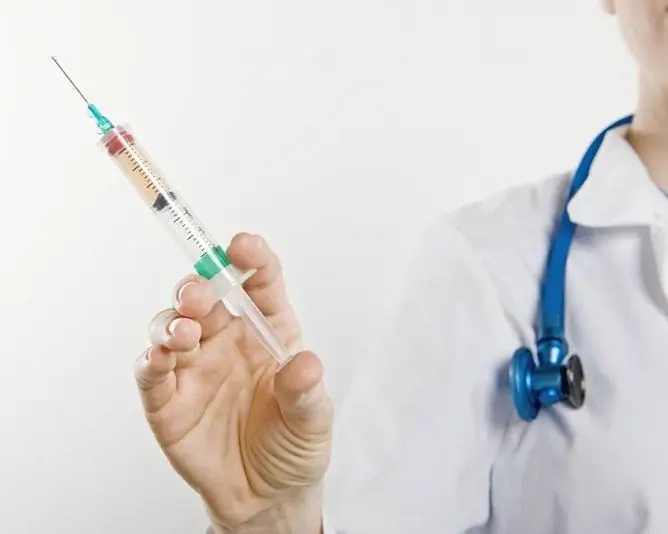- Author Rachel Wainwright [email protected].
- Public 2023-12-15 07:39.
- Last modified 2025-11-02 20:14.
Piracetam bufus
Piracetam bufus: instructions for use and reviews
- 1. Release form and composition
- 2. Pharmacological properties
- 3. Indications for use
- 4. Contraindications
- 5. Method of application and dosage
- 6. Side effects
- 7. Overdose
- 8. Special instructions
- 9. Application during pregnancy and lactation
- 10. Use in childhood
- 11. In case of impaired renal function
- 12. For violations of liver function
- 13. Use in the elderly
- 14. Drug interactions
- 15. Analogs
- 16. Terms and conditions of storage
- 17. Terms of dispensing from pharmacies
- 18. Reviews
- 19. Price in pharmacies
Latin name: Piracetam bufus
ATX code: N06BX03
Active ingredient: piracetam (Piracetam)
Producer: JSC "PFK Obnovlenie" (Russia)
Description and photo update: 2019-08-07
Prices in pharmacies: from 49 rubles.
Buy

Piracetam bufus is a nootropic agent.
Release form and composition
Dosage form - solution for intravenous and intramuscular administration: transparent colorless or slightly colored liquid (5 ml each in polymer ampoules, in a cardboard box of 10 or 100 ampoules and instructions for use of Piracetam bufus).
Composition of 1 ml solution:
- active substance: piracetam - 200 mg;
- auxiliary components: acetic acid, water for injection, sodium acetate.
Pharmacological properties
Pharmacodynamics
The active ingredient of Piracetam bufus - piracetam - is a cyclic derivative of gamma-aminobutyric acid (GABA), a nootropic agent. It has a direct effect on the brain, thereby improving cognitive processes: attention, memory, learning ability, mental performance.
The influence on the central nervous system is carried out in several ways, such as changing the rate of propagation of excitation in the brain, improving metabolic processes in nerve cells and microcirculation, and affecting the rheological characteristics of blood. Improves cerebral blood flow, synaptic conduction in neocortical structures and communication between the cerebral hemispheres. Does not have a vasodilator effect.
Piracetam bufus inhibits platelet aggregation, restores the elasticity of the erythrocyte membrane and reduces their adhesion. At a dose of 9600 mg, it reduces the level of fibrinogen and von Willebrand factor by 30-40%, and lengthens the bleeding time. In case of disorders of the brain function due to intoxication and hypoxia, it has a restorative and protective effect.
Reduces the severity and duration of vestibular nystagmus.
Pharmacokinetics
The half-life (T ½) of piracetam from blood plasma is 4-5 hours, from cerebrospinal fluid - 8.5 hours. In renal failure, T ½ is lengthened.
The drug does not bind to plasma proteins. It penetrates the blood-brain and placental barriers and membranes used in hemodialysis. In animal studies, it was found that piracetam selectively accumulates in the basal ganglia and tissues of the cerebral cortex, mainly in the occipital, frontal and parietal lobes in the cerebellum.
Piracetam is not metabolized in the body. It is excreted by the kidneys unchanged by renal filtration. In healthy volunteers, the renal clearance is 86 ml / min.
Indications for use
The indications for the use of Piracetam bufus are:
- symptomatic therapy of intellectual-mnestic disorders in patients without a confirmed diagnosis of dementia;
- decrease in the manifestations of cortical myoclonus in patients sensitive to piracetam (as monotherapy or as part of a complex treatment).
Contraindications
Absolute:
- psychomotor agitation at the time of prescribing Piracetam bufus;
- acute disturbance of cerebral circulation (hemorrhagic stroke);
- chorea of Huntington;
- end-stage renal failure [creatinine clearance (CC) <20 ml / min];
- children under 3 years old;
- lactation period;
- individual intolerance to any component of the drug or pyrrolidone derivatives.
Relative (Piracetam bufus should be used with caution):
- heavy bleeding;
- violation of hemostasis;
- extensive surgical interventions;
- mild to moderate renal failure (dose adjustment required);
- pregnancy (provided that the benefits exceed the risks).
Piracetam bufus, instructions for use: method and dosage
Piracetam bufus solution can be administered intravenously (preferably) or intramuscularly. The drug is prescribed to patients who cannot take piracetam in oral dosage forms (for example, with difficulty swallowing or unconsciousness).
Intravenous infusion of a daily dose is performed through a catheter for 24 hours at a constant rate. The total volume of the solution is determined by the doctor depending on the indications and the clinical condition of the patient.
For bolus administration of Piracetam bufus, the daily dose is divided into 2-4 injections at regular intervals. The maximum single dose is 3000 mg. The duration of one injection is at least 2 minutes.
Intramuscular injections of Piracetam buffus are carried out if the introduction through a vein is difficult. In this case, the single volume of the solution should not exceed 5 ml. The frequency of injections is the same as for intravenous or oral administration.
In the future, if the opportunity arises, the patient is transferred to other oral piracetam preparations.
The duration of treatment is determined by the doctor depending on the characteristics of the disease and the dynamics of symptoms.
Recommended dosage regimens:
- intellectual-mnestic disorders: 2400-4800 mg per day for 2-3 injections;
- cortical myoclonus: the initial daily dose is 7200 mg, then, at intervals of 3-4 days, the dose is increased by 4800 mg per day until the maximum daily dose of 24000 mg is reached (in 2-3 injections). Treatment is long-term, every 6 months, attempts should be made to reduce the dose or to cancel Piracetam bufus, gradually (every 2 days) reducing the dose by 1200 mg.
For patients with functional impairment of the kidneys, the dose is reduced depending on the level of CC. For men, this figure can be calculated based on serum creatinine concentration (CC syvorot), using the following formula: QC (ml / min) = [140 - age (years) x weight (kg)] / [72 x QC syvorot (mg / ml)]. To obtain CC in women, you should calculate the indicator using the same formula and multiply the resulting value by a factor of 0.85.
Recommended dosage regimens depending on QC:
- 50-79 ml / min - ⅔ the usual daily dose for 2-3 injections;
- 30-49 ml / min - ⅓ the usual daily dose for 2 injections;
- 20-29 ml / min - 1 ∕ 6 usual daily dose for 1 injection;
- <20 ml / min - the use of Piracetam bufus is contraindicated.
Side effects
Side effects identified in clinical trials:
- from the nervous system: often - hyperkinesis (1.72%); infrequently - drowsiness (0.96%), asthenia (0.23%);
- on the part of the psyche: often - nervousness (1.13%); infrequently - depression (0.83%);
- from the side of metabolism: often - an increase in body weight (1.29%).
Side effects registered during post-registration observation (the frequency of their occurrence is unknown, since the available data are insufficient):
- from the nervous system: insomnia, headache, imbalance, ataxia, tremor, exacerbation of epilepsy;
- from the side of the psyche: hallucinations, anxiety, agitation, confusion;
- on the part of the blood and lymphatic system: hemorrhagic disorders;
- from the digestive system: abdominal pain, diarrhea, gastralgia, nausea, vomiting;
- on the part of the reproductive system: increased sexual desire;
- from the hearing organs: vertigo;
- from the skin: urticaria, itching, dermatitis;
- allergic reactions: hypersensitivity reactions, anaphylactoid reactions, angioedema;
- others: pain in the area of injection, thrombophlebitis, arterial hypotension (with intravenous administration), hyperthermia.
Overdose
A single case of overdose was recorded after taking piracetam orally at a daily dose of 75,000 mg. The patient presented with dyspeptic disorders such as bloody diarrhea and abdominal pain. These symptoms are likely related to the high total dose of sorbitol contained in the oral preparation. There are no other reports of overdose cases.
Treatment is symptomatic. There is no specific antidote. If necessary, it is possible to carry out hemodialysis (this procedure allows you to remove from the body about 50-60% of the dose of the drug).
special instructions
Piracetam bufus has antiplatelet properties, therefore, it should be used with caution in the following cases: severe hemorrhagic disorders, the risk of bleeding (for example, against the background of gastric ulcer), hemostasis disorders, a history of hemorrhagic cerebrovascular disorders, surgical interventions (including dental), admission anticoagulants and antiplatelet agents (including acetylsalicylic acid in low doses).
In patients with cortical myoclonus, Piracetam bufus should not be discontinued abruptly, since in this case, seizures may resume.
It should be borne in mind that piracetam is able to penetrate the filter membranes of hemodialysis machines.
Influence on the ability to drive vehicles and complex mechanisms
During the period of nootropic therapy, precautions should be taken by vehicle drivers and persons performing potentially hazardous work requiring speed of reactions and high attention.
Application during pregnancy and lactation
Animal studies have not revealed a direct or indirect effect of the drug on fetal formation, pregnancy and childbirth, postnatal development. There have been no controlled studies on the effects of piracetam on pregnancy in humans. It has been established that the drug penetrates the placental barrier and reaches concentrations in the child that are 70-90% of the mother's plasma level. In this regard, during pregnancy, the doctor can prescribe Piracetam bufus only if the woman's clinical condition requires treatment with this drug, and the benefits of therapy are definitely higher than the potential risks.
Piracetam passes into breast milk, so you should avoid using it during lactation or stop breastfeeding.
Pediatric use
Intravenous administration and intramuscular injections of Piracetam bufus are contraindicated in children under 3 years of age.
With impaired renal function
The use of the drug is contraindicated in patients with end-stage renal failure (CC <20 ml / min).
If there are indications for the use of Piracetam bufus, it should be prescribed with caution in case of mild to moderate renal failure, adjusting the dose depending on the CC value.
For violations of liver function
There is no need to change the treatment regimen for patients with functional disorders of the liver.
Use in the elderly
Elderly patients may require dose adjustment of Piracetam bufus due to age-related decline in renal function. During treatment, it is necessary to monitor QC.
Drug interactions
Piracetam is excreted mainly (90%) unchanged, so the likelihood of changes in its pharmacokinetic parameters under the influence of other drugs is low.
When Piracetam bufus is prescribed to patients receiving thyroid hormones, sleep disturbances, irritability, and confusion may occur. In a published study that followed patients with recurrent venous thrombosis, piracetam, administered at a daily dose of 9600 mg, did not affect the properties of acenocoumarol used at the dose required to achieve the International Normalized Ratio (INR). However, compared with monotherapy with acenocoumarol, the addition of piracetam (9600 mg per day) significantly reduced platelet aggregation, fibrinogen and von Willebrand factor concentration, beta-thromboglobulin release, and serum and blood viscosity.
Piracetam at concentrations of 142, 426 and 1422 mg / ml does not inhibit cytochrome P 450 isozymes. When using the drug at a concentration of 1422 mg / ml, minimal inhibition of CUR 2A6 (21%) and 3A 4/5 (11%) was noted. However, the normal values of the inhibition constant, presumably, can be achieved at a higher concentration. Thus, a metabolic interaction of piracetam with other drugs is unlikely.
When Piracetam bufus was prescribed at a daily dose of 20,000 mg for 4 weeks to patients with epilepsy receiving stable doses of antiepileptic drugs (such as valproate, phenytoin, carbamazepine, phenobarbital), there were no changes in the maximum serum concentration and the area under the concentration-time curve »These drugs.
Ethanol does not affect serum piracetam levels. The drug at a dose of 1600 mg did not change the level of ethanol in the blood.
Analogs
Piracetam bufus analogs are: Amilonosar, Anvifen, Boluses Huato, Gleazer, Gliatilin, Idebenon, Quinel, Cortexin, Lucetam, Memotopil, Neipilept, Noben, Nootropil, Pantogam, Recognan, Semaxez, Tselemylitoretura, Tsvetamil Encephabol, Escotropil, etc.
Terms and conditions of storage
Store at temperatures below 25 ° C, protected from light, out of reach of children.
The shelf life is 5 years.
Terms of dispensing from pharmacies
Dispensed by prescription.
Reviews about Piracetam bufus
According to reviews, Piracetam bufus is an effective nootropic agent that significantly improves attention and memory, eliminates headaches, dizziness, tinnitus and a feeling of increased fatigue. The drug is often prescribed in the recovery period after a stroke, in the complex therapy of cervical osteochondrosis, with cerebrovascular accidents and cognitive impairments.
Additionally, patients note the low cost of Piracetam bufus, as well as the convenient and safe polymer ampoules. Many people prefer piracetam in oral dosage forms because of the ease of administration, but indicate that the effect develops faster after injections.
Adverse reactions include nervousness, sleep disturbances, and aggressiveness in children.
Price for Piracetam Buffus in pharmacies
The approximate price for Piracetam bufus 200 mg / ml for a pack of 10 ampoules of 5 ml, depending on the pharmacy chain, can be 38-67 rubles.
Piracetam bufus: prices in online pharmacies
|
Drug name Price Pharmacy |
|
Piracetam bufus 200 mg / ml solution for intravenous and intramuscular administration 5 ml 10 pcs. RUB 49 Buy |
|
Piracetam bufus 200 mg / ml solution for intravenous and intramuscular administration 5 ml 100 pcs. 336 r Buy |

Maria Kulkes Medical journalist About the author
Education: First Moscow State Medical University named after I. M. Sechenov, specialty "General Medicine".
Information about the drug is generalized, provided for informational purposes only and does not replace the official instructions. Self-medication is hazardous to health!






